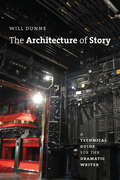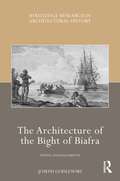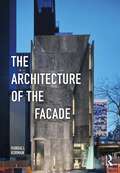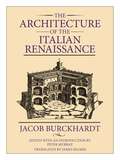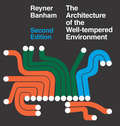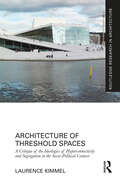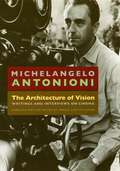- Table View
- List View
The Architecture of Story: A Technical Guide for the Dramatic Writer (Chicago Guides to Writing, Editing, and Publishing)
by Will DunneWhile successful plays tend to share certain storytelling elements, there is no single blueprint for how a play should be constructed. Instead, seasoned playwrights know how to select the right elements for their needs and organize them in a structure that best supports their particular story. Through his workshops and book The Dramatic Writer’s Companion, Will Dunne has helped thousands of writers develop successful scripts. Now, in The Architecture of Story, he helps writers master the building blocks of dramatic storytelling by analyzing a trio of award-winning contemporary American plays: Doubt: A Parable by John Patrick Shanley, Topdog/Underdog by Suzan-Lori Parks, and The Clean House by Sarah Ruhl. Dismantling the stories and examining key components from a technical perspective enables writers to approach their own work with an informed understanding of dramatic architecture. Each self-contained chapter focuses on one storytelling component, ranging from “Title” and “Main Event” to “Emotional Environment” and “Crisis Decision.” Dunne explores each component in detail, demonstrating how it has been successfully handled in each play and comparing and contrasting techniques. The chapters conclude with questions to help writers evaluate and improve their own scripts. The result is a nonlinear reference guide that lets writers work at their own pace and choose the topics that interest them as they develop new scripts. This flexible, interactive structure is designed to meet the needs of writers at all stages of writing and at all levels of experience.
The Architecture of Story: A Technical Guide for the Dramatic Writer (Chicago Guides to Writing, Editing, and Publishing)
by Will DunneWhile successful plays tend to share certain storytelling elements, there is no single blueprint for how a play should be constructed. Instead, seasoned playwrights know how to select the right elements for their needs and organize them in a structure that best supports their particular story. Through his workshops and book The Dramatic Writer’s Companion, Will Dunne has helped thousands of writers develop successful scripts. Now, in The Architecture of Story, he helps writers master the building blocks of dramatic storytelling by analyzing a trio of award-winning contemporary American plays: Doubt: A Parable by John Patrick Shanley, Topdog/Underdog by Suzan-Lori Parks, and The Clean House by Sarah Ruhl. Dismantling the stories and examining key components from a technical perspective enables writers to approach their own work with an informed understanding of dramatic architecture. Each self-contained chapter focuses on one storytelling component, ranging from “Title” and “Main Event” to “Emotional Environment” and “Crisis Decision.” Dunne explores each component in detail, demonstrating how it has been successfully handled in each play and comparing and contrasting techniques. The chapters conclude with questions to help writers evaluate and improve their own scripts. The result is a nonlinear reference guide that lets writers work at their own pace and choose the topics that interest them as they develop new scripts. This flexible, interactive structure is designed to meet the needs of writers at all stages of writing and at all levels of experience.
The Architecture of the Bight of Biafra: Spatial Entanglements (Routledge Research in Architectural History)
by Joseph GodlewskiThe Architecture of the Bight of Biafra challenges linear assumptions about agency, progress, and domination in colonial and postcolonial cities, adding an important sub‑Saharan case study to existing scholarship on globalization and modernity.Intersected by small creeks, rivulets, and dotted with mangrove swamps, the Bight of Biafra has a long history of decentralized political arrangements and intricate trading networks predating the emergence of the Atlantic world. While indigenous merchants in the region were active participants in the transatlantic slave trading system, they creatively resisted European settlement and maintained indigenous sovereignty until the middle of the nineteenth century. Since few built artifacts still exist, this study draws from a close reading of written sources—travelers’ accounts, slave traders’ diaries, missionary memoirs, colonial records, and oral histories—as well as contemporary fieldwork to trace transformations in the region’s built environment from the sixteenth century to today. With each chapter focusing on a particular spatial paradigm in this dynamic process, this book uncovers the manifold and inventive ways in which actors strategically adapted the built environment to adjust to changing cultural and economic circumstances. In parallel, it highlights the ways that these spaces were rhetorically constructed and exploited by foreign observers and local agents. Enmeshed in the history of slavery, colonialism, and the modern construction of race, the spatial dynamics of the Biafran region have not been geographically delimited. The central thesis of this volume is that these spaces of entanglement have been productive sites of Black identity formation involving competing and overlapping interests, occupying multiple positions and temporalities, and ensnaring real, imagined, and sometimes contradictory aims.This book will be of interest to researchers and students of architecture, architectural history, urban geography, African studies, and Atlantic studies.
The Architecture of the Bight of Biafra: Spatial Entanglements (Routledge Research in Architectural History)
by Joseph GodlewskiThe Architecture of the Bight of Biafra challenges linear assumptions about agency, progress, and domination in colonial and postcolonial cities, adding an important sub‑Saharan case study to existing scholarship on globalization and modernity.Intersected by small creeks, rivulets, and dotted with mangrove swamps, the Bight of Biafra has a long history of decentralized political arrangements and intricate trading networks predating the emergence of the Atlantic world. While indigenous merchants in the region were active participants in the transatlantic slave trading system, they creatively resisted European settlement and maintained indigenous sovereignty until the middle of the nineteenth century. Since few built artifacts still exist, this study draws from a close reading of written sources—travelers’ accounts, slave traders’ diaries, missionary memoirs, colonial records, and oral histories—as well as contemporary fieldwork to trace transformations in the region’s built environment from the sixteenth century to today. With each chapter focusing on a particular spatial paradigm in this dynamic process, this book uncovers the manifold and inventive ways in which actors strategically adapted the built environment to adjust to changing cultural and economic circumstances. In parallel, it highlights the ways that these spaces were rhetorically constructed and exploited by foreign observers and local agents. Enmeshed in the history of slavery, colonialism, and the modern construction of race, the spatial dynamics of the Biafran region have not been geographically delimited. The central thesis of this volume is that these spaces of entanglement have been productive sites of Black identity formation involving competing and overlapping interests, occupying multiple positions and temporalities, and ensnaring real, imagined, and sometimes contradictory aims.This book will be of interest to researchers and students of architecture, architectural history, urban geography, African studies, and Atlantic studies.
The Architecture of the Facade
by Randall KormanThe Architecture of the Facade provides a comprehensive study of the facade as both a physical and cultural artifact, highlighting its significance as a critical component of the civic realm and arguing for the restoration of the art of the facade as both a subject of study within academia and an aspiration within the profession at large. As the principal surface of mediation, contextualization, and representation, the facade carries the lion’s share of responsibility for containing the internal environment and confronting the outer world. And yet, in recent decades, the very question of what exactly a facade is has been raised by the dramatic changes in building technology, advances of parametric design, and the ubiquity of autonomous buildings. The Architecture of the Facade addresses these and other related issues. The book is organized into 12 chapters, with each chapter focusing on a particular aspect of the phenomenon of the facade such as those of wall, the frame, transparency, and the role of the facade in civic space. Korman also discusses proportional systems, the language of composition, the role of precedent, the importance of context, and much more. Over 350 photos and diagrams provide readers with a variety of examples of artful facades throughout history. Online teaching resources that accompany this book include a course syllabus, a glossary, and a Pinterest tack board of facades. This book will be of great interest to students in architecture studios as well as instructors and professional architects interested in facade design.
The Architecture of the Facade
by Randall KormanThe Architecture of the Facade provides a comprehensive study of the facade as both a physical and cultural artifact, highlighting its significance as a critical component of the civic realm and arguing for the restoration of the art of the facade as both a subject of study within academia and an aspiration within the profession at large. As the principal surface of mediation, contextualization, and representation, the facade carries the lion’s share of responsibility for containing the internal environment and confronting the outer world. And yet, in recent decades, the very question of what exactly a facade is has been raised by the dramatic changes in building technology, advances of parametric design, and the ubiquity of autonomous buildings. The Architecture of the Facade addresses these and other related issues. The book is organized into 12 chapters, with each chapter focusing on a particular aspect of the phenomenon of the facade such as those of wall, the frame, transparency, and the role of the facade in civic space. Korman also discusses proportional systems, the language of composition, the role of precedent, the importance of context, and much more. Over 350 photos and diagrams provide readers with a variety of examples of artful facades throughout history. Online teaching resources that accompany this book include a course syllabus, a glossary, and a Pinterest tack board of facades. This book will be of great interest to students in architecture studios as well as instructors and professional architects interested in facade design.
The Architecture of the Illusive Distance
by Amir H. AmeriFocusing on three secular institutional building types: libraries, museums, and cinemas, this book explores the intricate interplay between culture and architecture. It explores the cultural imperatives which have seen to the formation of these institutions, the development of their architecture, and their transformation over time. The relationship between culture and architecture is often perceived as a monologic relationship. Architecture is seen to embody, represent and/or reflect the values, the beliefs, and the aesthetic ideals of a culture. Ameri argues that this is at best a partial and restrictive view, and that if architecture is a cultural statement, it is a performative one. It does not merely represent culture, but constructs, reifies, and imposes culture as the unalterable shape of reality. Whereas the concept and the study of cultural performatives have had an important critical impact on the humanities, architecture as a cultural performative has not received the necessary scholarly attention and, in part, this book aims to fill this gap. Whereas building-type studies have been largely restricted to elucidating how best to design building-types based on historic and contemporary precedents, studies in the humanities that analytically and critically engage the secular institutions and their history as cultural performatives, typically cast a blind or perfunctory glance at the performative complicity of their architecture. This book aims to address the omissions in both these approaches. The library, the museum, and the movie-theater have been selected for close critical study because, this book argues, each has been instituted to house, ’domesticate,’ and restrain a specific form of representation. The aim has been to protect and promulgate the metaphysics of presence as Jacques Derrida expounds the concept. This book proposes that it is against the dangers of unconstrained cohabitation of reality and representation that the library, the m
The Architecture of the Illusive Distance
by Amir H. AmeriFocusing on three secular institutional building types: libraries, museums, and cinemas, this book explores the intricate interplay between culture and architecture. It explores the cultural imperatives which have seen to the formation of these institutions, the development of their architecture, and their transformation over time. The relationship between culture and architecture is often perceived as a monologic relationship. Architecture is seen to embody, represent and/or reflect the values, the beliefs, and the aesthetic ideals of a culture. Ameri argues that this is at best a partial and restrictive view, and that if architecture is a cultural statement, it is a performative one. It does not merely represent culture, but constructs, reifies, and imposes culture as the unalterable shape of reality. Whereas the concept and the study of cultural performatives have had an important critical impact on the humanities, architecture as a cultural performative has not received the necessary scholarly attention and, in part, this book aims to fill this gap. Whereas building-type studies have been largely restricted to elucidating how best to design building-types based on historic and contemporary precedents, studies in the humanities that analytically and critically engage the secular institutions and their history as cultural performatives, typically cast a blind or perfunctory glance at the performative complicity of their architecture. This book aims to address the omissions in both these approaches. The library, the museum, and the movie-theater have been selected for close critical study because, this book argues, each has been instituted to house, ’domesticate,’ and restrain a specific form of representation. The aim has been to protect and promulgate the metaphysics of presence as Jacques Derrida expounds the concept. This book proposes that it is against the dangers of unconstrained cohabitation of reality and representation that the library, the m
The Architecture of the Italian Renaissance (World Of Art Ser.)
by Jacob Burckhardt"There may not be any book on architecture so delightful to dip into; one wishes there were a pocket edition to take on an Italian vacation—not only for its information and vision but for such pleasant reminders as that the citizens of Treviso carried Tullio Lombardo's friezes through the town in triumph before they were attached to a building."—D. J. R. Bruckner, New York Times Book Review
Architecture of the Well-Tempered Environment
by Reyner BanhamReyner Banham was a pioneer in arguing that technology, human needs, and environmental concerns must be considered an integral part of architecture. No historian before him had so systematically explored the impact of environmental engineering on the design of buildings and on the minds of architects. In this revision of his classic work, Banham has added considerable new material on the use of energy, particularly solar energy, in human environments. Included in the new material are discussions of Indian pueblos and solar architecture, the Centre Pompidou and other high-tech buildings, and the environmental wisdom of many current architectural vernaculars.
Architecture of the Well-Tempered Environment
by Reyner BanhamReyner Banham was a pioneer in arguing that technology, human needs, and environmental concerns must be considered an integral part of architecture. No historian before him had so systematically explored the impact of environmental engineering on the design of buildings and on the minds of architects. In this revision of his classic work, Banham has added considerable new material on the use of energy, particularly solar energy, in human environments. Included in the new material are discussions of Indian pueblos and solar architecture, the Centre Pompidou and other high-tech buildings, and the environmental wisdom of many current architectural vernaculars.
Architecture of Threshold Spaces: A Critique of the Ideologies of Hyperconnectivity and Segregation in the Socio-Political Context (Routledge Research in Architecture)
by Laurence KimmelThis book explores the relationship between architecture and philosophy through a discussion on threshold spaces linking public space with publicly accessible buildings. It explores the connection between exterior and interior and how this creates and affects interactions between people and the social dynamics of the city. Building on an existing body of literature, the book engages with critical philosophy and discusses how it can be applied to architecture. In a similar vein to Walter Benjamin’s descriptions of the Parisian Arcades in the nineteenth century, the book identifies the conditions under which thresholds reveal and impact social life. It utilises a wide range of illustrated international case studies from architects in Japan, Norway, Finland, France, Portugal, Italy, the USA, Australia, Mexico, and Brazil. Within the examples, thresholds become enhancers of social interactions and highlight broader socio-political contexts in public and private space. Architecture of Threshold Spaces is an enlightening contribution to knowledge on contemporary architecture, politics and philosophy for students, academics, and architects.
Architecture of Threshold Spaces: A Critique of the Ideologies of Hyperconnectivity and Segregation in the Socio-Political Context (Routledge Research in Architecture)
by Laurence KimmelThis book explores the relationship between architecture and philosophy through a discussion on threshold spaces linking public space with publicly accessible buildings. It explores the connection between exterior and interior and how this creates and affects interactions between people and the social dynamics of the city. Building on an existing body of literature, the book engages with critical philosophy and discusses how it can be applied to architecture. In a similar vein to Walter Benjamin’s descriptions of the Parisian Arcades in the nineteenth century, the book identifies the conditions under which thresholds reveal and impact social life. It utilises a wide range of illustrated international case studies from architects in Japan, Norway, Finland, France, Portugal, Italy, the USA, Australia, Mexico, and Brazil. Within the examples, thresholds become enhancers of social interactions and highlight broader socio-political contexts in public and private space. Architecture of Threshold Spaces is an enlightening contribution to knowledge on contemporary architecture, politics and philosophy for students, academics, and architects.
The Architecture of Transgression (Architectural Design)
by Rachel Sara Jonathan MosleyTransgression suggests operating beyond accepted norms and radically reinterpreting practice by pushing at the boundaries of both what architecture is, and what it could or even should be. The current economic crisis and accompanying political/social unrest has exacerbated the difficulty into which architecture has long been sliding: challenged by other professions and a culture of conservatism, architecture is in danger of losing its prized status as one of the pre-eminent visual arts. Transgression opens up new possibilities for practice. It highlights the positive impact that working on the architectural periphery can make on the mainstream, as transgressive practices have the potential to reinvent and reposition the architectural profession: whether they are subverting notions of progress; questioning roles and mechanisms of production; aligning with political activism; pioneering urban interventions; advocating informal or incomplete development; actively destabilising environments or breaking barriers of taste. In this new dispersed and expanded field of operation, the balance of architectural endeavour is shifted from object to process, from service to speculation, and from formal to informal in a way that provides both critical and political impetus to proactively affect change. Contributors: Can Altay, Edward Denison and Guangyu Ren, Kim Dovey, Chris Jenks, David Littlefield, Silvia Loeffler, Alistair Parvin, Louis Rice, Patrik Schumacher and Robin Wilson Featured architects: atelier d’architecture autogérée, Lina Bo Bardi, Construire/La Machine, EXYZT, Didier Faustino/Bureau des Mésarchitectures, Lacaton & Vassal, N55, Catie Newell/*Alibi Studio, Wang Shu, Superflex and Bernard Tschumi
The Architecture of Urbanity: Designing for Nature, Culture, and Joy
by Vishaan ChakrabartiFrom one of today&’s most inspired architects and urban advocates, a manifesto for architecture as a force for addressing our biggest social challengesThe world is facing unprecedented challenges, from climate change and population growth, to political division and technological dislocation, to declining mental health and fraying cultural fabric. With most of the planet&’s population now living in urban environments, cities are the spaces where we have the greatest potential to confront and address these problems. In this visionary book, Vishaan Chakrabarti argues for an &“architecture of urbanity,&” showing how the design of our communities can create a more equitable, sustainable, and joyous future for us all.Taking readers from the great cities of antiquity to the worldwide exurban sprawl of our postindustrial age, Chakrabarti examines architecture&’s relationship to history&’s greatest social, technological, and environmental dilemmas. He then presents a rich selection of work by a global array of practicing architects, demonstrating how innovative design can dramatically improve life in big cities and small settlements around the world, from campuses and refugee camps to mega-cities like São Paulo, Lima, Los Angeles, New York, Paris, and Tokyo.Lavishly illustrated with a wealth of original graphics, data visualizations, photographs, and drawings, The Architecture of Urbanity eloquently explains why cities are the last, best hope for humanity, and why designers must, alongside political, business, community, and cultural leaders, steward the healing of our planet.
The Architecture of Use: Aesthetics and Function in Architectural Design
by Stephen Grabow Kent SpreckelmeyerBy analyzing ten examples of buildings that embody the human experience at an extraordinary level, this book clarifies the central importance of the role of function in architecture as a generative force in determining built form. Using familiar twentieth-century buildings as case studies, the authors present these from a new perspective, based on their functional design concepts. Here Grabow and Spreckelmeyer expand the definition of human use to that of an art form by re-evaluating these buildings from an aesthetic and ecological view of function. Each building is described from the point of view of a major functional concept or idea of human use which then spreads out and influences the spatial organization, built form and structure. In doing so each building is presented as an exemplar that reaches beyond the pragmatic concerns of a narrow program and demonstrates how functional concepts can inspire great design, evoke archetypal human experience and help us to understand how architecture embodies the deeper purposes and meanings of everyday life.
The Architecture of Use: Aesthetics and Function in Architectural Design
by Stephen Grabow Kent SpreckelmeyerBy analyzing ten examples of buildings that embody the human experience at an extraordinary level, this book clarifies the central importance of the role of function in architecture as a generative force in determining built form. Using familiar twentieth-century buildings as case studies, the authors present these from a new perspective, based on their functional design concepts. Here Grabow and Spreckelmeyer expand the definition of human use to that of an art form by re-evaluating these buildings from an aesthetic and ecological view of function. Each building is described from the point of view of a major functional concept or idea of human use which then spreads out and influences the spatial organization, built form and structure. In doing so each building is presented as an exemplar that reaches beyond the pragmatic concerns of a narrow program and demonstrates how functional concepts can inspire great design, evoke archetypal human experience and help us to understand how architecture embodies the deeper purposes and meanings of everyday life.
The Architecture of Vision: Writings and Interviews on Cinema
by Michelangelo Antonioni“A filmmaker is a man like any other; and yet his life is not the same. . . . This is, I think, a special way of being in contact with reality.” Or so says Michelangelo Antonioni, the legendary filmmaker behind the stark landscapes and social alienation of Blow-Up and L’Avventura, who here reveals his idiosyncratic relationship with reality in The Architecture of Vision. Through autobiographical sketches, theoretical essays, interviews, and conversations with such luminaries as Jean-Luc Godard and Alberto Moravia, this compelling volume explores the director’s unique brand of narrative-defying cinema as well as the motivations and anxieties of the man behind the camera. “The Architecture of Vision provides a filmmaker’s absorbing reflections and insights on his career. . . . Antonioni’s comments . . . deepen and humanize a sometimes cerebral book.”—Publishers Weekly “[Antonioni’s] erudition is astonishing . . . few of his peers can match his verbal articulateness.”—Film Quarterly “This valuable resource offers entrée to material difficult to gain access to under other circumstances.”—Library Journal
The Architecture of Waste: Design for a Circular Economy
by Caroline O’DonnellGlobal material crises are imminent. In the very near future, recycling will no longer be a choice made by those concerned about the environment, but a necessity for all. This means a paradigm shift in domestic behavior, manufacturing, construction, and design is inevitable. The Architecture of Waste provides a hopeful outlook through examining current recycling practices, rethinking initial manufacturing techniques, and proposing design solutions for second lives of material-objects. The book touches on a variety of inescapable issues beyond our global waste crisis including cultural psyches, politics, economics, manufacturing, marketing, and material science. A series of crucial perspectives from experts cover these topics and frames the research by providing a past, present, and future look at how we got here and where we go next: the historical, the material, and the design. Twelve design proposals look beyond the simple application of recycled and waste materials in architecture—an admirable endeavor but one that does not engage the urgent reality of a circular economy—by aiming to transform familiar, yet flawed, material-objects into closed-loop resources. Complete with over 150 color images and written for both professionals and students, The Architecture of Waste is a necessary reference for rethinking the traditional role of the architect and challenging the discipline to address urgent material issues within the larger design process.
The Architecture of Waste: Design for a Circular Economy
by Caroline O'Donnell Dillon PrangerGlobal material crises are imminent. In the very near future, recycling will no longer be a choice made by those concerned about the environment, but a necessity for all. This means a paradigm shift in domestic behavior, manufacturing, construction, and design is inevitable. The Architecture of Waste provides a hopeful outlook through examining current recycling practices, rethinking initial manufacturing techniques, and proposing design solutions for second lives of material-objects. The book touches on a variety of inescapable issues beyond our global waste crisis including cultural psyches, politics, economics, manufacturing, marketing, and material science. A series of crucial perspectives from experts cover these topics and frames the research by providing a past, present, and future look at how we got here and where we go next: the historical, the material, and the design. Twelve design proposals look beyond the simple application of recycled and waste materials in architecture—an admirable endeavor but one that does not engage the urgent reality of a circular economy—by aiming to transform familiar, yet flawed, material-objects into closed-loop resources. Complete with over 150 color images and written for both professionals and students, The Architecture of Waste is a necessary reference for rethinking the traditional role of the architect and challenging the discipline to address urgent material issues within the larger design process.
Architecture on the Borderline: Boundary Politics and Built Space (Architext)
by Anoma PierisArchitecture on the Borderline interrogates space and territory in a turbulent present where nation-state borders are porous to a few but impermeable to many. It asks how these uneven and conflicted social realities are embodied in the physical and material conditions imagined, produced or experienced through architecture and urbanism. Drawing on historical, global examples, this rich collection of essays illustrates how empires, nations and cities expand their frontiers and contest boundaries, but equally how borderline identities of people and places influence or expose these processes. Empirical chapters covering Central Asia, the Asia Pacific region, the American continent, Europe and the Middle East offer multiple critical insights into the ways in which our spatial imagination is contingent on ‘border-thinking’; on the ways of being and navigating frontiers, boundaries and margins, the three themes used to organise their content. The underlying premise of the book is that sensitisation to border conditions can alter our understanding of the static physical spaces that service political or cultural ideologies, and that the view from the periphery opens up new ways of understanding sovereignty. In exploring these various spaces and their transformative subjectivities, this book also reveals the unrelenting precarity of contesting and living on the margins, and related spaces and discourses that are neglected or suppressed.
Architecture on the Borderline: Boundary Politics and Built Space (Architext)
by Anoma PierisArchitecture on the Borderline interrogates space and territory in a turbulent present where nation-state borders are porous to a few but impermeable to many. It asks how these uneven and conflicted social realities are embodied in the physical and material conditions imagined, produced or experienced through architecture and urbanism. Drawing on historical, global examples, this rich collection of essays illustrates how empires, nations and cities expand their frontiers and contest boundaries, but equally how borderline identities of people and places influence or expose these processes. Empirical chapters covering Central Asia, the Asia Pacific region, the American continent, Europe and the Middle East offer multiple critical insights into the ways in which our spatial imagination is contingent on ‘border-thinking’; on the ways of being and navigating frontiers, boundaries and margins, the three themes used to organise their content. The underlying premise of the book is that sensitisation to border conditions can alter our understanding of the static physical spaces that service political or cultural ideologies, and that the view from the periphery opens up new ways of understanding sovereignty. In exploring these various spaces and their transformative subjectivities, this book also reveals the unrelenting precarity of contesting and living on the margins, and related spaces and discourses that are neglected or suppressed.
Architecture or Revolution: Emancipatory Critique After Marx
by Nadir LahijiBy linking building theory to the emancipatory project of critique advanced by radical thinkers in our time, this work investigates the key conceptual and historical elements that culminate in an emancipatory theory of building entitled: 'Toward a philosophy of shelter’. Taking Marx as its only resource, this work proceeds with the conviction that our era is contemporaneous to Marx’s historical era. This means ‘not judging the validity of Marx from the perspective of the historical situation’, but rather, ‘demonstrating the validity of a Marxian perspective for a singular historical situation’, as ours. This work will therefore translate this perspective into seeing the situation of architecture through the eyes of Marx. All those concerned with the predicament in our current condition in which architecture must play a major social role in upholding the universal value of what Alain Badiou calls 'generic humanity' will take an interest in this work. In particular, architects, critics, scholars, and students inside the field of architecture who would be seeking the application of this universal value to a new theory of building will be a welcoming audience for this work.
Architecture or Revolution: Emancipatory Critique After Marx
by Nadir LahijiBy linking building theory to the emancipatory project of critique advanced by radical thinkers in our time, this work investigates the key conceptual and historical elements that culminate in an emancipatory theory of building entitled: 'Toward a philosophy of shelter’. Taking Marx as its only resource, this work proceeds with the conviction that our era is contemporaneous to Marx’s historical era. This means ‘not judging the validity of Marx from the perspective of the historical situation’, but rather, ‘demonstrating the validity of a Marxian perspective for a singular historical situation’, as ours. This work will therefore translate this perspective into seeing the situation of architecture through the eyes of Marx. All those concerned with the predicament in our current condition in which architecture must play a major social role in upholding the universal value of what Alain Badiou calls 'generic humanity' will take an interest in this work. In particular, architects, critics, scholars, and students inside the field of architecture who would be seeking the application of this universal value to a new theory of building will be a welcoming audience for this work.
Architecture, Participation and Society
by Paul Jenkins Leslie ForsythHow can architects best increase their engagement with building users and wider society to provide better architecture? Since the mid 1990s government policy has promoted the idea of greater social participation in the production and management of the built environment but there has been limited direction to the practising architect. Reviewing international cases and past experiences to analyze what lessons have been learnt, this book argues for participation within other related disciplines, and makes a set of recommendations for architectural practices and other key actors.
